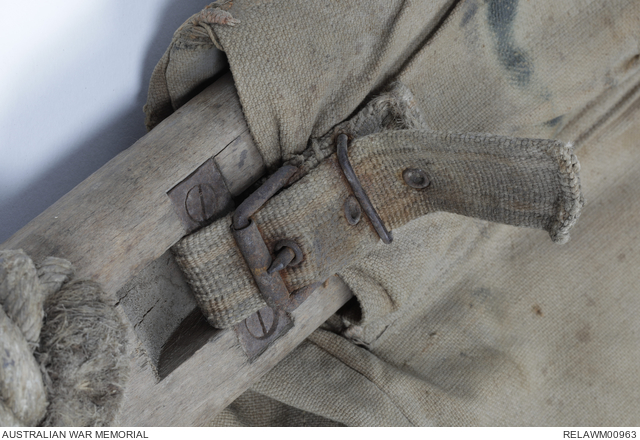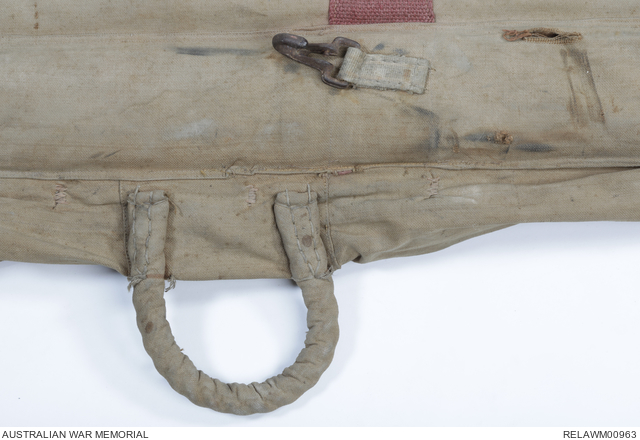| Place | Europe: France, Picardie, Somme, Mont St Quentin |
|---|---|
| Accession Number | RELAWM00963 |
| Collection type | Heraldry |
| Object type | Heraldry |
| Physical description | Canvas, Metal, Rope, Wood |
| Maker |
Unknown |
| Place made | Germany |
| Date made | c 1918 |
| Conflict |
First World War, 1914-1918 |
German casualty stretcher : 20th Battalion, AIF
































Camel coloured flexible canvas stretcher supported longitudinally by two wooden planks. The stretcher has a closeable double-flap canvas body to encompass the patient. The 'feet' end of the stretcher is sewn into a tubular pocket. Attached to the internal flat bed of the stretcher by a morone-coloured heavy canvas strip is a padded 'V'-shaped harness. The harness is designed to pass between the legs of the patient and secure over the waist by two swivel eye hooks. These may be secured to one of six circular metal links placed equidistantly along both sides of the stretcher.
Onto the inside of the inner flap on the left upper quadrant are the inked words 'W.H.Wise 20th Bn Pioneers'.
On the right upper quadrant, nailed into the wooden support plank is a small brass plate with the text 'GERMAN TRENCH STRETCHER / CAPTURED BY THE 20th AUS / INF BATTALION AT MT ST / QUENTIN. ON THE SOMME. / FRANCE. 31.8.18'
The inner flaps of canvas have a printed fabric square of German script, the translation of this reads:
'User Manual for stretcher for trench use. Open the fold out supports of the stretcher which is placed on the ground. If no bone fracture in legs or feet place the unconscious person onto stretcher so that the soles of the feet touch the foot supports. In case of fracture the feet may not touch the foot supports. Place the thigh support belts between legs and over hips and pull tight to the sides and upwards. Pull the buckles high. Close the support flaps. Pull the cord through opening at head end and secure with knot. The injured should be carried if possible horizontally. If sufficient space multiple persons should hold the handles. In narrow passages two people carry the stretcher at the foot and head ends. In angled or zigzag passages the stretcher is carried slowly and carefully vertically by single carrier using the shoulder straps on his back.'
The outer flaps have eight Y-strap metal hooks and one large metal eyelet on each side. These are offset and designed so that the two outer flaps can be laced together using cord or wire. At the feet end of the stretcher the two wooden slats are capped with metal. A hole has been drilled through both slats, and there is a loop handle of rope attached to each. At the head end of the stretcher two reinforced canvas straps have been attached to the stretcher, presumably to pull it.
The stretcher has three canvas covered rope handles on either side for carrying.Underneath the stretcher are two heavy canvas shoulder straps - one has been torn off - in dirty white with parallel navy borders. The stretcher is designed to be carried by its rope handles, but the shoulder straps may be employed in an emergency by a single bearer for short distances only. There are two wadded rectangular pads (328mm x 105mm) attached to the body of the stretcher to cushion the shoulders of the bearer.
The stretcher was captured at the Battle of Mont St Quentin on 31 August 1918 and forms part of a collection of enemy equipment captured by 20th Battalion as a result of their (and other battalion's) successful and rapid assault towards Mont St Quentin. Members of 20th Battalion including Wally Brown VC and Privates Wise and Kent planned to create a 20th Battalion museum after the war.
The material captured by the 20th Battalion was documented in the Unit Diary [AWM4 23/37/37 PART 1 - August 1918 Appendices] and was handed over to the Australian War Records Section on 16 September 1918 at Frise, during the Divisional Sports Day. Apart from the trench stretcher, the captured material included a klaxon, a collection of rifles, a machine gun base and ammunition boxes, a pioneer saw, and a collection of 4.5 inch and 5.9 inch shell charge cases.